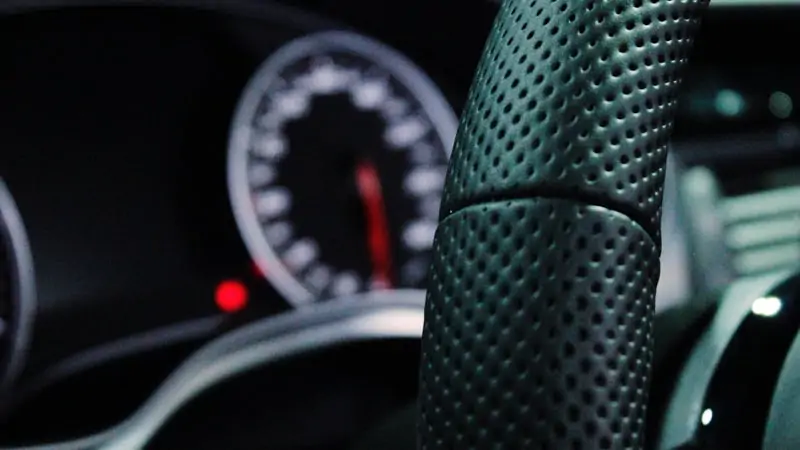According to auto experts, poor steering handling is one of the common causes of crashes. In case you don’t know, the steering wheel is designed to be handled in a certain way. For instance, for several years, the standard way of handling the steering wheel is to hold it at the 10 and 2 positions, which is known to reduce the crash rate.
Furthermore, the steering wheel comes with a couple of safety components – one of them is the horn button. The button is designed to help drivers signal others, keeping them aware of the vehicle’s presence or approach.
Bumps located on the steering wheel are designed to make it easy for drivers to identify the pressing zone for the horn. Such bumps are very common in older vehicles, but a few modern cars also have bumps on their steering device.
Why exactly do steering wheels have bumps at 10 and 2? What is the function of the bumps on your vehicle’s steering wheel? Is there braille on car steering wheels? As you read through the rest of this article, you’ll find answers to the questions above.
Why Do Steering Wheels Have Bumps At 10 And 2?

What Is The “10 And 2” Steering Wheel Holding Technique?
A steering system is, no doubt, one of the most important components of your car. Without it, there’s no way you’ll be able to drive your car and change directions quickly. That’s so because the steering wheel is the one responsible for setting the direction of your car.
Apart from helping to set the direction of your vehicle, another function of the steering system is that it helps to provide stability, which makes your car run smoothly. The steering wheel is the control wheel that allows you to steer your vehicle the right way.
According to NHTSA, driver errors, as a result of improper steering wheel techniques, are one of the main causes of a car crash. Many people don’t know the proper way of holding their vehicle’s steering wheel. Some don’t even think it matters.
You need to understand that proper holding of your car’s steering wheel is something you need to observe at all times. That’s so because it’s a very important safety precaution for driving.
For many years, the standard way of handling the steering wheel is to hold it at the 10 and 2 positions. For those who don’t know, the numbers above are referring to a clock. This means you should see your steering wheel as a clock and position your hands where the “two” and “ten” numbers would be.
However, you need to understand that holding the steering wheel at the 10 and 2 positions is no longer valid today. Here’s why; the 10 and 2 positioning of your hands on the steering wheel was more popular before the era of power steering as the standard for vehicles. At that time, it requires a lot of force to steer the wheel and get your vehicle to shift to your preferred direction.
Today, however, power steering has made it easier for drivers to steer their vehicles without stress. Here’s the thing; by holding your steering wheel at 10 and 2, you’ll end up pulling down on the wheel when turning. But this is no longer important since power steering has become the standard for most vehicles.
That said, it’s safe to say that the 10 & 2 holding technique of the steering wheel is mostly recommended for older vehicles – those with no power steering. As for modern cars, the best handling positions for the steering wheel are at “9” and “3.”
What Are Bumps On The Steering Wheel?
Now, let’s quickly talk about what “bumps” are before going ahead to address the question of why steering wheels have them on 10 and 2.
Bumps are dotted marks that you can find on a vehicle’s steering wheel. These dotted lines, as earlier mentioned, are there to make it easy and quick for drivers to identify the pressing zone for the horn.
Here’s Why Steering Wheels Have Bumps At 10 And 2

You already know what “bumps” and “10 & 2” steering wheel holding positions mean. But, why are bumps on the steering wheels located at 10 and 2?
It’s simple; you need to first understand that bumps are mostly located on the steering wheels of older vehicles. Furthermore, as earlier mentioned, the 10 and 2 positions are only recommended for older vehicles with no power steering.
So, if you can see the bumps located at 10 and 2, it means the vehicle you’re using is an older model. At the time of manufacturing the vehicle, the standard steering wheel holding positions are 10 and 2. This explains why the steering wheel of the vehicle has bumps at 10 and 2.
What Are Bumps On Steering Wheels For?
As you already know, the main reason why the bumps are placed on the steering wheels is to make it pretty easy and quick for drivers to locate the pressing zone for the horn. This way, they can always press the horn bottom quickly without necessarily having to look at the steering wheel at all times.
Is There Braille On Car Steering Wheels?
To many people, the small bumps on the steering wheels of older vehicles are braille, which helps blind drivers locate the horn quickly and apply it at the appropriate time. However, you need to understand that the small bumps aren’t designed for that purpose.
According to the European Automobile Manufacturers’ Association (ACEA), as cited by Reuters, the small bumps on the steering wheels of older cars are designed to allow drivers to identify the pressing zone for the horn. As such, the small bumps on the steering wheels of vehicles are not “braille” as most people claim.

